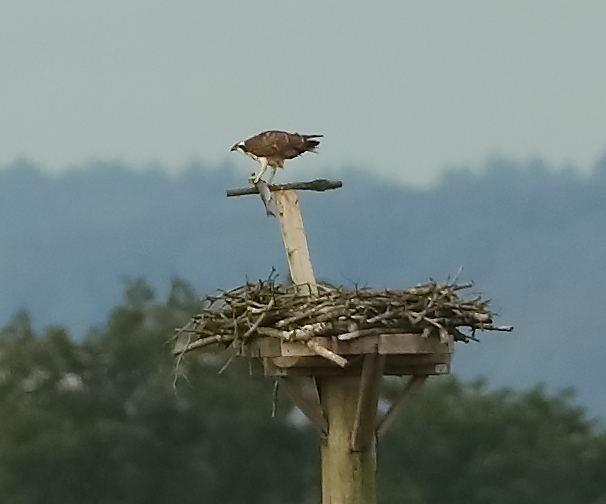Translocation project hopes to re-establish Ospreys in Poole Harbour
An Osprey translocation programme has been given the go-ahead in Poole Harbour, Dorset, this year as the first stage in establishing a south-coast breeding population of this popular bird.
Led by local charity Birds of Poole Harbour, Scottish charity the Roy Dennis Wildlife Foundation and local Poole based-business Wildlife Windows, the five-year project aims to restore Osprey to its former breeding grounds in the south of England, where it once had the local nickname 'Mullet Hawk' after its fish-eating habits. Osprey historically bred across the whole of Britain and north-west Europe, but its population drastically declined in the Middle Ages and it was lost from England by the mid–1800s.
The project will provide an important stepping stone between breeding populations in Britain and northern France, with the aim of enhancing the long-term survival of the western European population as a whole. The project is part of a wider conservation recovery plan for Osprey in western Europe and the Mediterranean region.
 for web.jpg)
Ospreys pass through Poole Harbour every spring and autumn, but it is hoped that the translocation project will encourage the species to return to breed (Peter Moore).
Ospreys are annual visitors to Poole Harbour as they pass through on their northward and southward migrations between breeding grounds in Scotland and central England and overwintering grounds in West Africa. Over the last eight years, efforts within the harbour have been made by the RSPB, National Trust, Natural England, The Forestry Commission and private landowners to try to attract Ospreys to stay and breed by erecting artificial nesting platforms, in the hope that the birds will adopt them as their own nests.

Osprey's current European distribution (BirdLife International).
Ospreys are semi-colonial nesters and often choose to breed in areas where others of the same species are nesting. In 2009, the RSPB went as far as placing decoy birds supplied by Roy Dennis on one of the nesting platforms on their Arne reserve in Dorset. Although there has been some interest by Osprey in these nesting platforms over that eight-year period, none have remained to breed and it's now thought a translocation project is the next logical step. Translocation has proved a highly successful means by which to restore the species into its former range. The much-admired population at Rutland Water, Leicestershire, was established by a pioneering translocation project in the late 1990s, and similar work has since taken place in two regions of Spain as well as in Italy, Portugal and Switzerland.
This pan-European approach means that the Poole Harbour project, which will involve licensed collection of five-six week-old chicks from healthy, sustainable populations in Scotland, has the best possible chance of success. Once collected, the chicks will be safely brought down to Poole Harbour and held in large holding pens at a confidential site for just two-three weeks to acclimatise to their new home and prepare for their first flights. Once released, they will be provided with fresh fish on artificial nests to replicate normal Osprey behaviour, and so will be likely to remain around Poole Harbour for a further six weeks (the normal post-fledging period), before beginning their long migration to West Africa. During this six-week period the birds will imprint on the area and adopt Poole as their new home.
Paul Morton from the Birds of Poole Harbour stated: "The main issue that limits the spread of Ospreys is their natural dispersal. When young Ospreys return to breed for the first time, males prefer to nest in the area where they themselves were raised, while females tend to settle close to where other Ospreys are nesting. These factors combined mean that the natural expansion of the species is very slow — often as little as [five miles] per year. This project will help to significantly speed up this process and restore Osprey to the south coast, where we know that they were once a common sight.
"The experience of other projects in Europe indicates that we should start seeing translocated Ospreys returning to their adopted home of Poole Harbour two-three years after they are released."
Every autumn Poole Harbour can host up to six Osprey at any one time, attracted by the abundance of salt-water fish species such as mullet, with the last two weeks of August and first two weeks of September being the optimum time to see them as they fatten up before their long journey south to West Africa.

Osprey, Arne RSPB, Dorset, (Photo: Mike Trew).
Osprey tourism is hugely popular with the top four Osprey visitor attractions in Britain, raising around £4 million each year for local economies between the months of March and August. Paul Morton said: "We hope that this is a project that the whole community will get behind. In other parts of the country there is great excitement when the Ospreys return each spring, and in years to come it would be marvellous if there is a similar feeling in Poole and along other parts of the south coast."
Roy Dennis and Tim Mackrill from the Roy Dennis Wildlife Foundation added: "This project is the next logical step in the conservation of Ospreys in the UK and western Europe. The Rutland project completely changed the distribution of the species in the south of the country, but they remain a very rare breeding bird in England despite the fact that extensive areas of suitable habitat exist. Establishing a population of Ospreys on the south coast where estuaries provide extremely rich fishing grounds will be another positive step forward and help to link existing populations in Rutland, Wales and France, as part of a pan-European recovery of the species."

